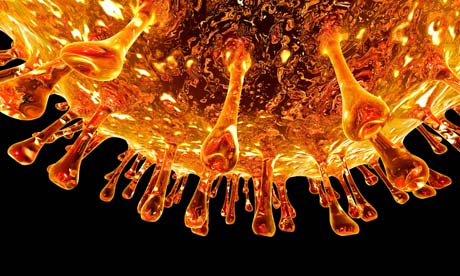
The following correction was was printed in the Guardian's Corrections and clarifications column, Tuesday 28 July 2009
A front-page caption indicated that the spiky amber-coloured sphere being shown was a photograph of an H1N1 (swine flu) virus particle. In fact, it was a computer generated impression – one of many seen in a range of hues in the press and on TV at the moment – of what such a particle might look like, based on known characteristics of the virus. Under the credit style used in our captions, we should have called it an image. The Science Photo Library, which supplies this material, is clear in labelling it as artwork.
About 100,000 people caught swine flu in England last week, the chief medical officer revealed today, as the government's online diagnosis service crashed within minutes of launch when thousands of people tried to log on at the same time.
The rapid spread of the virus was confirmed as the National Pandemic Flu Service – dispensing advice and anti-viral prescriptions over the telephone and online – went live to relieve pressure on GPs.
The world's first government-run swine flu diagnosis website could not cope with the volume of traffic when it opened for business at 3pm today. Designed to handle 1,200 hits a second, the service was suspended just four minutes later when 2,600 people tried to access it every second.
The service's inauspicious launch came as new official figures on consultation rates with GPs showed that:
• the infection has spread broadly across the country from the hotspots where it was initially concentrated;
• under-14s are the most affected;
• 840 patients in England are receiving hospital treatment for illnesses associated with the H1N1 virus, of whom 63 are in intensive care. Comparable figures for the previous week were: 652 in hospital and 53 in intensive care.
In another development, a pregnant woman critically ill with swine flu was transferred to Sweden for specialised treatment after suffering a rare complication.
The 26-year-old Scot was flown out because all five beds were occupied at the national unit in Leicester that provides the highly specialised procedure known as extracorporeal membrane oxygenation (ECMO), which involves circulating the patient's blood outside the body and adding oxygen to it artificially.
Nationally, the Department of Health said there were hopeful signs, producing a revised death rate that showed lower than anticipated fatalities and suggesting there could be a lull in infections over the summer.
Following a rigorous investigation of reported fatalities, Sir Liam Donaldson, the chief medical officer, said there had been 26 "provisionally validated" swine flu deaths in England since the beginning of the outbreak. Combined with four deaths reported in Scotland, the UK total stood at 30.
Unlike normal seasonal flu, which is a threat primarily to the pneumonia-prone elderly, the H1N1 virus appears to affect the young more severely. Of those who have died in England, a third were under the age of 15 while only 17% of fatalities have been among pensioners.
Within the same sample of 26 deaths, two-thirds of the victims had what were described as pre-existing "severe conditions" such as leukaemia, and only 16% were described as fully "healthy".
The infection rate has almost doubled from an estimated 55,000 new cases in the previous week to 100,000 fresh cases. A slight dip in daily consultation rates with GPs within the last few days has given some health officials hope that the first wave of infections may have peaked in Britain, Donaldson said. "You will see a suggestion of a downturn but I don't think you can read too much into it at this stage," he added.
A scenario anticipated by Department of Health officials and those from other departments who meet regularly in the Cabinet Office's emergency planning committee, Cobra, is for a slowdown in the infection rate during the summer when schools are closed. The outbreak may pick up pace again in the autumn.
Donaldson said there was no evidence of the virus becoming more virulent and stressed that for most people it would be relatively mild. He denied there was a danger of a shortage of respirators for children in intensive care beds. "We can expand capacity somewhat in the event of an emergency by cancelling some routine operations," he added.
The fact that rates of influenza-like illness are running at a far higher level than those normally observed during high summer remains a puzzle for scientists. In previously severe outbreaks activity dipped.
"This level in July and August is highly unusual," Donaldson said.
Tower Hamlets in east London continues to be the primary care trust with the highest number of GP consultations for people with flu-like illness. It is seeing 792 consultations for every 100,000 people, followed by Islington in north London with 488 consultations for every 100,000 people.
Other parts of England that are severly affected include Greenwich, south-east London, Leicester, and Telford and Wrekin, Shropshire. In Wales, 3,075 people contacted their GPs in the past week with symptoms of the H1N1 virus.
Swine flu infection rates in Scotland appear to have reached record levels, with the virus spreading uniformly across the country, despite hopes the outbreak may have peaked.

